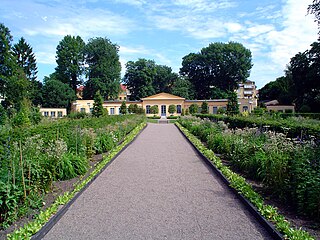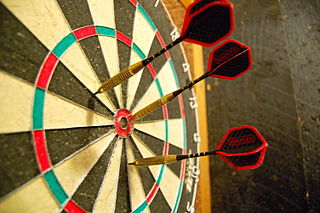
Backgammon is a two-player board game played with counters and dice on tables boards. It is the most widespread Western member of the large family of tables games, whose ancestors date back at least 1,600 years. The earliest record of backgammon itself dates to 17th-century England, being descended from the 16th-century game of Irish.

Chess is a board game for two players. It is sometimes called international chess or Western chess to distinguish it from related games such as xiangqi and shogi.

Dominoes is a family of tile-based games played with gaming pieces. Each domino is a rectangular tile, usually with a line dividing its face into two square ends. Each end is marked with a number of spots or is blank. The backs of the tiles in a set are indistinguishable, either blank or having some common design. The gaming pieces make up a domino set, sometimes called a deck or pack. The traditional European domino set consists of 28 tiles, also known as pieces, bones, rocks, stones, men, cards or just dominoes, featuring all combinations of spot counts between zero and six. A domino set is a generic gaming device, similar to playing cards or dice, in that a variety of games can be played with a set. Another form of entertainment using domino pieces is the practice of domino toppling.

The Exposition Universelle of 1855, better known in English as the 1855 Paris Exposition, was a world's fair held on the Champs-Élysées in Paris, France, from 15 May to 15 November 1855. Its full official title was the Exposition Universelle des produits de l'Agriculture, de l'Industrie et des Beaux-Arts de Paris 1855. It was the first of ten major expositions held in the city between 1855 and 1937. Nowadays, the exposition's sole physical remnant is the Théâtre du Rond-Point des Champs-Élysées, designed by architect Gabriel Davioud, which originally housed the Panorama National.
In chess, there are a number of ways that a game can end in a draw, neither player winning. Draws are codified by various rules of chess including stalemate, threefold repetition, and the fifty-move rule. Under the standard FIDE rules, a draw also occurs in a dead position, most commonly when neither player has sufficient material to checkmate the opponent.

The International Code of Nomenclature for algae, fungi, and plants is the set of rules and recommendations dealing with the formal botanical names that are given to plants, fungi and a few other groups of organisms, all those "traditionally treated as algae, fungi, or plants". It was formerly called the International Code of Botanical Nomenclature (ICBN); the name was changed at the International Botanical Congress in Melbourne in July 2011 as part of the Melbourne Code which replaced the Vienna Code of 2005.

Darts or dart-throwing is a competitive sport in which two or more players bare-handedly throw small sharp-pointed projectiles known as darts at a round target known as a dartboard.

A convention center is a large building that is designed to hold a convention, where individuals and groups gather to promote and share common interests. Convention centers typically offer sufficient floor area to accommodate several thousand attendees. Very large venues, suitable for major trade shows, are sometimes known as exhibition halls. Convention centers typically have at least one auditorium and may also contain concert halls, lecture halls, meeting rooms, and conference rooms. Some large resort area hotels include a convention center.
This is a timeline of chess.

Blindfold chess, also known as sans voir, is a form of chess play wherein the players do not see the positions of the pieces and do not touch them. This forces players to maintain a mental model of the positions of the pieces. Moves are communicated via a recognized chess notation.

The PIF ATP Rankings are the merit-based method used by the Association of Tennis Professionals (ATP) for determining the qualification for entry as well as the seeding of players in all singles and doubles tournaments. The first rankings for singles were published on 23 August 1973 while the doubles players were ranked for the first time on 1 March 1976. Ranking points are awarded according to the stage of tournament reached, and the prestige of the tournament, with the four Grand Slam tournaments awarding the most points. The rankings are updated every Monday, and points are dropped 52 weeks after being awarded. Jannik Sinner is the current men's singles world No. 1.

London 1851 was the first international chess tournament. The tournament was conceived and organised by English player Howard Staunton, and marked the first time that the best chess players in Europe would meet in a single event. Adolf Anderssen of Germany won the sixteen-player tournament, earning him the status of the best player in the world.
The Baden-Baden 1870 chess tournament was one of the strongest chess tournaments ever at the time. The tournament lasted from 18 July until 4 August 1870, in Baden-Baden. It was won by Adolf Anderssen, ahead of Wilhelm Steinitz.

A chess tournament is a series of chess games played competitively to determine a winning individual or team. Since the first international chess tournament in London, 1851, chess tournaments have become the standard form of chess competition among multiple serious players.
Henry Hosmer was a nineteenth-century American chess master. He is known to have played in only two significant chess tournaments: the Second and Third American Chess Congresses in 1871 and 1874.
The Paris 1878 chess tournament took place from 17 June to 31 July 1878 during the Paris World Expo. The participation of George Henry Mackenzie and James Mason made it the first intercontinental tournament in Europe. Eleven double rounds were played. Wilhelm Steinitz was present as reporter for The Field.
The Paris 1900 chess tournament was an event held in conjunction with the Exposition Universelle (1900), one of the world's most notable fairs or exhibitions and designated a "World Exposition" by the Bureau of International Expositions. Major international chess tournaments were also held at six other expositions: London 1851, London 1862, Paris 1867, Vienna 1873, Philadelphia 1876 and Paris 1878. No chess events of significance accompanied, for instance, the Exposition Universelle (1889) in Paris or the World's Columbian Exposition in Chicago in 1893.

Parade de cirque is an 1887-88 Neo-Impressionist painting by Georges Seurat. It was first exhibited at the 1888 Salon de la Société des Artistes Indépendants in Paris, where it became one of Seurat's least admired works. Parade de cirque represents the sideshow of the Circus Corvi at place de la Nation, and was his first depiction of a nocturnal scene, and first painting of popular entertainment. Seurat worked on the theme for nearly six years before completing the final painting.
Novak Djokovic defeated Stefanos Tsitsipas in the final, 6–7(6–8), 2–6, 6–3, 6–2, 6–4 to win the men's singles tennis title at the 2021 French Open. It was his second French Open title and 19th major title overall. With this victory, he became the first man to achieve the double career Grand Slam in the Open Era, and the first player in the Open Era to win a major after coming back from two sets to love down in two matches during the same major. Tsitsipas became the first Greek player to reach a major final. It also marked the second consecutive year a man trailed by two sets in a major final yet rallied to win, following Dominic Thiem's victory at the 2020 US Open.
 Ignatz von Kolisch (Hungary)
Ignatz von Kolisch (Hungary) Szymon Winawer (Poland)
Szymon Winawer (Poland) Wilhelm Steinitz (Bohemia)
Wilhelm Steinitz (Bohemia) Gustav Richard Neumann (Prussia)
Gustav Richard Neumann (Prussia) Cecil Valentine De Vère (United Kingdom)
Cecil Valentine De Vère (United Kingdom) Jules Arnous de Rivière (France)
Jules Arnous de Rivière (France) Celso Golmayo Zúpide (Spain)
Celso Golmayo Zúpide (Spain) Hieronim Ignacy Czarnowski (France)
Hieronim Ignacy Czarnowski (France) Samuel Rosenthal (France)
Samuel Rosenthal (France) Samuel Loyd (United States)
Samuel Loyd (United States) Emile d’André (France)
Emile d’André (France) Martin Severin From (Denmark)
Martin Severin From (Denmark) Eugène Rousseau (France)
Eugène Rousseau (France)










